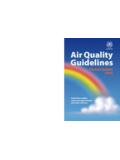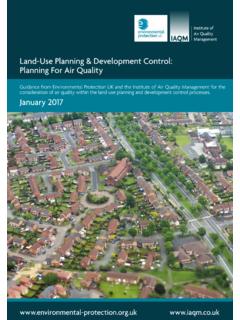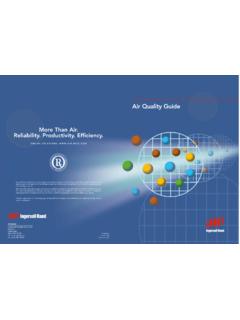Transcription of The Role and Application of Traceability, Calibration ...
1 National air quality Reference Laboratories and the European Network AQUILA: Roles and Requirements for Measurement traceability , Accreditation, quality Assurance/ quality Control, and Measurement Comparisons, at National and European Levels Version 2, December 2009 This document can be found at: 1 National air quality Reference Laboratories and the European Network AQUILA: Roles and Requirements for Measurement traceability , Accreditation, quality Assurance/ quality Control, and Measurement Comparisons, at National and European Levels Table of Contexts Chapter 1: National air quality Reference Laboratories and the AQUILA Network: Introduction, General Objectives, and Terms & Drivers for the Establishment of National air quality Reference Laboratories , and Requirements for the AQUILA Network, arising from European Union National Reference Laboratories: What are they?
2 How are they appointed? What are they responsible for?..7 General Objectives and Main Aims of Chapter 2: The Applications and Role of Measurement traceability , Traceable Calibration Standards, and Certified Reference Materials, in Ambient air quality What is traceability ?..12 The Realization and Dissemination of Traceable Measurement Standards at a National Level: Certified Reference Materials and their Roles in quality Assurance and quality Control: Definitions and The Realization and Dissemination of Traceable Standards and Certified Reference Materials at a National Level: Ambient Methods for the Production of Calibration Standards Traceable Directly to SI Units.
3 Ambient Preparation of Gaseous Calibration Purity Requirements for Diluent Gases, Calibration Gas Species, and Zero Methods using Certified Reference Materials, and their Role in quality Assurance and quality Control: Ambient Calibration Methods that use Primary Measurement Techniques Not Directly Traceable to SI Units: Ambient Methods not Traceable to SI Units or Primary Methods, Realized by Convention or Definition as Reference Methods: Ambient Methods for Disseminating traceability by Means of National or International Standards or Reference Methods: Ambient Dissemination for Methods Using Calibration Standards Produced with Concentration Values Linked Directly to SI units: Ambient Dissemination for Methods that Use CRMs for quality Control and quality Assurance: Ambient Dissemination Using Primary Methods: Ambient 2 Table of Contexts (continued) Dissemination using Reference Methods Designated by Convention or by Regulation.
4 Ambient International Comparisons to demonstrate Comparability of Measurements between Summary of Comparisons Organised by the EC Joint Research International Comparisons carried out by the CCQM and Associated International Comparisons of Ambient-Air Calibration Chapter 3: Interpretation, Design, and Implementation, of quality Systems for European National Reference Initial Development of the New European and Worldwide quality -Assurance General quality Assurance and quality Control Requirements for European and National Reference Additional Responsibilities of NRLs that Relate to quality Assurance at a National Chapter 4.
5 Type Approval Testing and Product Certification of Automated Instruments used for Ambient air quality Definitions and Reference Methods/CEN Standards and Type Approval CEN Standards with Requirements for Type Summary of Type-approval Requirements within the CEN Requirements for the Certification of Type-approved EN 15267 Part 1: Certification of automated measuring systems General Need for Certification across Scope of the EN 15267 Part 1 EN 15267 Part 2: Certification of automated monitoring systems Initial assessment of the AMS manufacturer s quality management system, and post-certification surveillance of the manufacturing Possible Roles for an Towards a Harmonised European Chapter 5.
6 quality Assurance and quality Control in Ambient Air- quality Monitoring Networks at a National Level, Operated for EU Regulatory General Principles of quality Assurance and quality Control as Applied to air quality Requirements of the CEN Standard Type Approval of Field Operation and on-going QA/QC 55 Suitability Evaluation and Initial Requirements for Ongoing 3 Table of Contents (continued) Data Calculating the overall Expanded Uncertainty of the Measurement traceability and Other Requirements of the EN ISO 17025 Further Requirements of QA/QC Systems for EU Regulated Pollutants57 QA/QC Activities Linked to the Collecting and Reporting of the Measurement Demonstration of Inter-laboratory Comparisons at a National Background to the Types of Inter-Laboratory Evaluation of the Results of the ILC at a National Links to ILCs at a European
7 Examples of Specific Recommendations for NRLs at a National Chapter 6: Intercomparisons Carried Out By the EC s Joint Research Centre, Examples for Inorganic Gaseous Compounds: Ozone, Carbon Monoxide, Nitrogen Oxides, and Sulphur Examples for Organic Gaseous Compounds: BTEX and VOC Ozone VOC Ozone Examples for PM Constituents: Heavy Metals and Heavy Example of PM10 and Annex 1: Organisation of Intercomparison Exercises for Gaseous Air Pollution for EU National Air Reference Laboratories and Laboratories of the WHO EURO ANNEX 2: Background to the Requirements for quality Systems from the Previous Directive 1996/62 4 5 Chapter 1: National air quality Reference Laboratories and the AQUILA Network.
8 Introduction, General Objectives, and Terms & Definitions Overview This Document provides the background, the context, and certain regulatory and scientific information, on the European Network of National air quality Reference Laboratories, known as AQUILA, which has been active since its constitution in December 2001. The AQUILA Network is made up of National Reference Laboratories from European countries. This document also defines what constitutes National air quality Reference Laboratories, and specifies their roles and responsibilities in a number of important scientific and technical areas.
9 Drivers for the Establishment of National air quality Reference Laboratories , and Requirements for the AQUILA Network, arising from European Union Directives air quality across the whole European Union (EU) is a field where the European Commission (EC) has been proactive in defining a comprehensive strategy and an implementation methodology. Recently, this has resulted in the plans and initiatives developed under the Clean Air for Europe (CAFE) programme. This Programme have also involved the publication, or the revision, of a range of EU directives, concerned both with ambient air quality and atmospheric pollution emissions to the atmosphere.
10 The directives currently of most relevance to this document are: 2008/50/EC The new Directive of the European Parliament and of the Council on ambient air quality and cleaner air for Europe (Official Journal of the European Union L152 ). 2004/107/EC - 4th Daughter directive: relating to arsenic, nickel, cadmium, mercury and polycyclic aromatic hydrocarbons in ambient air; In addition, for completeness, it should be considered that this document covers the requirements of the previously published directives listed below, which will be repealed by June 2011 as the new Directive is required to be transposed in all Member States: 1996/62/EC - air quality Framework directive on ambient air quality assessment and management.
















